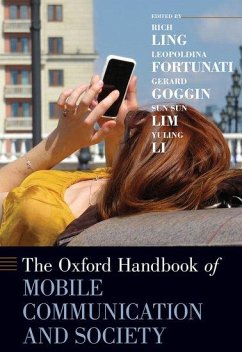The Oxford Handbook of Mobile Communication and Society
Herausgeber: Ling, Rich; Li, Yuling; Lim, Sun Sun; Goggin, Gerard; Fortunati, Leopoldina
The Oxford Handbook of Mobile Communication and Society
Herausgeber: Ling, Rich; Li, Yuling; Lim, Sun Sun; Goggin, Gerard; Fortunati, Leopoldina
- Gebundenes Buch
- Merkliste
- Auf die Merkliste
- Bewerten Bewerten
- Teilen
- Produkt teilen
- Produkterinnerung
- Produkterinnerung
This book examines the social consequences of mobile communication in the era of the smartphone and how the smartphone has positively and negatively impacted society.
Andere Kunden interessierten sich auch für
![The Facts Are The Facts Are]() George SeldesThe Facts Are35,99 €
George SeldesThe Facts Are35,99 €![The Oxford Encyclopedia of Journalism Studies The Oxford Encyclopedia of Journalism Studies]() The Oxford Encyclopedia of Journalism Studies742,99 €
The Oxford Encyclopedia of Journalism Studies742,99 €![HDTV and the Transition to Digital Broadcasting HDTV and the Transition to Digital Broadcasting]() Philip CianciHDTV and the Transition to Digital Broadcasting66,99 €
Philip CianciHDTV and the Transition to Digital Broadcasting66,99 €![The Language of Journalism The Language of Journalism]() The Language of Journalism204,99 €
The Language of Journalism204,99 €![Wharton Esherick's Illuminated & Illustrated Song of the Broad-Axe: By Walt Whitman Wharton Esherick's Illuminated & Illustrated Song of the Broad-Axe: By Walt Whitman]() The Wharton Esherick MuseumWharton Esherick's Illuminated & Illustrated Song of the Broad-Axe: By Walt Whitman31,99 €
The Wharton Esherick MuseumWharton Esherick's Illuminated & Illustrated Song of the Broad-Axe: By Walt Whitman31,99 €![The Business of Scholarly Publishing The Business of Scholarly Publishing]() Albert N GrecoThe Business of Scholarly Publishing56,99 €
Albert N GrecoThe Business of Scholarly Publishing56,99 €![The Publishing Family of Rivington The Publishing Family of Rivington]() Septimus RivingtonThe Publishing Family of Rivington37,99 €
Septimus RivingtonThe Publishing Family of Rivington37,99 €-
-
-
This book examines the social consequences of mobile communication in the era of the smartphone and how the smartphone has positively and negatively impacted society.
Hinweis: Dieser Artikel kann nur an eine deutsche Lieferadresse ausgeliefert werden.
Hinweis: Dieser Artikel kann nur an eine deutsche Lieferadresse ausgeliefert werden.
Produktdetails
- Produktdetails
- Verlag: Hurst & Co.
- Seitenzahl: 736
- Erscheinungstermin: 19. Mai 2020
- Englisch
- Abmessung: 252mm x 187mm x 55mm
- Gewicht: 1623g
- ISBN-13: 9780190864385
- ISBN-10: 0190864389
- Artikelnr.: 58263295
- Herstellerkennzeichnung
- Libri GmbH
- Europaallee 1
- 36244 Bad Hersfeld
- gpsr@libri.de
- Verlag: Hurst & Co.
- Seitenzahl: 736
- Erscheinungstermin: 19. Mai 2020
- Englisch
- Abmessung: 252mm x 187mm x 55mm
- Gewicht: 1623g
- ISBN-13: 9780190864385
- ISBN-10: 0190864389
- Artikelnr.: 58263295
- Herstellerkennzeichnung
- Libri GmbH
- Europaallee 1
- 36244 Bad Hersfeld
- gpsr@libri.de
Rich Ling is Professor of Media Technology at Nanyang Technological University in Singapore. Gerard Goggin is Australian Research Council Future Fellow and Professor of Media and Communications at the University of Sydney in Australia. Leopoldina Fortunati is Professor of Sociology of Communication and Sociology of Cultural Processes at the Faculty of Education of the University of Udine in Italy. Sun Sun Lim is Head of Humanities, Arts and Social Sciences at the Singapore University of Technology and Design. Yuling Li is a freelance writer, editor, researcher, editorial consultant, and Associate Lecturer of Communication and Journalism Modules at Republic Polytechnic in Singapore.
* Foreword Tom Wheeler
* About the Contributors
* Section 1: The Smartphone Decade
* 1.1 An Introduction Rich Ling, Leopoldina Fortunati, Gerard Goggin,
Sun Sun Lim, and Yuling Li
* Section 2: Theoretical/Social Perspectives on Mobile Communication
* 2.1: Domestication Analyses and the Smartphone Leslie Haddon
* 2.2: Theories on the Adoption and Appropriation of Mobile Media
Veronika Karnowski
* 2.3: Mobiles and the Self: A Trajectory of Paradigmatic Change Scott
Campbell, Wenhuan Wang, and Joseph B. Bayer
* 2.4: The Mobile User's Mindset in a Permanently Online, Permanently
Connected Society Peter Vorderer and Christoph Klimmt
* 2.5: Polymedia and Mobile Communication Mirca Madianou
* 2.6: Mobile Convergence Leopoldina Fortunati and Maria Bakardjieva
* Section 3: Methods
* 3.1: Mobile Phones in Action: The Ethnomethodology and Conversation
Analysis Perspective Christian Licoppe
* 3.2: Mobile Methods: The Collection of Social Scientific Data On-And
With-Mobile Media Jeffrey Boase
* Section 4: Managing the Social Sphere via Mobile Communication
* 4.1: Digital Childhood? Global Perspectives on Children and Mobile
Technologies Mariya Stoilova, Sonia Livingstone, and Giovanna
Mascheroni
* 4.2: Intimacy in the App Age: Romantic Relationships and Mobile
Technology Annisa M. P. Rochadiat, Stephanie Tom Tong, and Elena F.
Corriero
* 4.3: The Social Consequences of Phubbing: A Framework and Research
Agenda Mariek Vanden Abeele
* 4.4: Mobile Messaging Apps and Relationship Management: The Case of
WeChat in China Di Cui and Xueqing Li
* 4.5: Older People Go Mobile Mireia Fernández-Ardèvol
* 4.6: Death and the Mobile Kathleen M. Cumiskey
* Section 5: Social Institutions
* 5.1: Mobile News Oscar Westlund
* 5.2: Mobile Media and Political Communication: Connect, Communicate,
and Participate Ran Wei
* 5.3: Political Protest and Mobile Communication Christina Neumayer
* 5.4 Learning with Mobiles or "Mobile Learning" John Traxler
* 5.5: Mobile Health: A Rapidly Maturing Digital Ecosystem for Health
Systems Strengthening Alain Labrique , Dustin Gibson, Radha Rajan,
Lavanya Vasudevan
* 5.6: Big Data for Social Good: The Role of Telecom Kenth Engø-Monsen
* Section 6: Organizational/Business Potentials of Mobile Communication
* 6.1: Mobile Communication of Organizations Carsten Sørensen
* 6.2: Mobile Marketing Nicholas Carah
* 6.3: The Complexities of Using Mobiles at Work Keri K. Stephens
* Section 7: Visual and Linguistic Dimensions
* 7.1: Self-(Re)presentation in Mobile Communication Practices Amparo
Lasén
* 7.2: Mobile Art: The Art of the Social Larissa Hjorth
* 7.3: Mobile Photography Rich Ling and Yuling Li
* 7.4: Talking, Reading, and Writing on Smartphones Naomi S. Baron
* Section 8: The Appification of Mobile Communication
* 8.1: Understanding Mobile Apps as Platform-Based Services in
Multisided Markets: Adoption and Diffusion Per Egil Pedersen and
Herbjørn Nysveen
* 8.2: The Message is the Medium: Mobile Instant Messaging Apps in the
Mobile Communication Ecosystem Juan Miguel Aguado and Inmaculada J.
Martínez
* 8.3: Ambient Play: Understanding Mobile Games in Everyday Life
Larissa Hjorth and Ingrid Richardson
* Section 9: Urban Mobility and Location-Based Services
* 9.1: RFID, NFC, Beacons, and the Infrastructures of Logistical
Locative Media Jordan Frith
* 9.2: Urban Mobility in Context: A Study About Location-Based Taxi
Hailing Apps in Rio de Janeiro Adriana de Souza e Silva, Cristiane
Damasceno, Daniela M. C. Bueno, and Justin Grandinetti
* 9.3: Autonomous Vehicles in the Mobility System Thilo von Pape
* Section 10: Cross- and Multi-Cultural Perspectives
* 10.1: Defining mGender: The Role of Mobile Phone Use in Gender
Construction Processes Xin Pei and Arul Chib
* 10.2: Gender, Empowerment, and Mobile Phones in the Developing World
Laura Stark
* Section 11: Challenges Posed by Mobile Communication
* 11.1: Privacy From Your Mobile Devices? Algorithmic Accountability,
Surveillance Capitalism, and the Accumulation of Personal Data Tim
Dwyer
* 11.2: Privacy on Smartphones: A Cross-National Study Bente Evjemo,
Gorm Grønnevet, Rich Ling, Wenche Nag, Helene Lie Røhr, and Ole
Christian Wasenden
* 11.3: Aggression Through Mobile Communication: Unraveling Its Motives
and Consequences Michel Walrave, Joris Van Ouytsel, and Koen Ponnet
* 11.4: Mobile Phone Waste and Circular Economy Tim Cooper, Matt
Shapley, and Christine Cole
* 11.5: Thinking Ethically About Mobile Devices: A Rough Guide Charles
Ess
* Section 12: The Future Social Consequences of Mobile Communication
* 12.1: Mobile Communication to Social Robotics: Relationships and
Emotions James E. Katz and Kate K. Mays
* 12.2: Robotization of Mobile Communication Sakari Taipale, Tuuli
Turja, and Lina Van Aerschot
* About the Contributors
* Section 1: The Smartphone Decade
* 1.1 An Introduction Rich Ling, Leopoldina Fortunati, Gerard Goggin,
Sun Sun Lim, and Yuling Li
* Section 2: Theoretical/Social Perspectives on Mobile Communication
* 2.1: Domestication Analyses and the Smartphone Leslie Haddon
* 2.2: Theories on the Adoption and Appropriation of Mobile Media
Veronika Karnowski
* 2.3: Mobiles and the Self: A Trajectory of Paradigmatic Change Scott
Campbell, Wenhuan Wang, and Joseph B. Bayer
* 2.4: The Mobile User's Mindset in a Permanently Online, Permanently
Connected Society Peter Vorderer and Christoph Klimmt
* 2.5: Polymedia and Mobile Communication Mirca Madianou
* 2.6: Mobile Convergence Leopoldina Fortunati and Maria Bakardjieva
* Section 3: Methods
* 3.1: Mobile Phones in Action: The Ethnomethodology and Conversation
Analysis Perspective Christian Licoppe
* 3.2: Mobile Methods: The Collection of Social Scientific Data On-And
With-Mobile Media Jeffrey Boase
* Section 4: Managing the Social Sphere via Mobile Communication
* 4.1: Digital Childhood? Global Perspectives on Children and Mobile
Technologies Mariya Stoilova, Sonia Livingstone, and Giovanna
Mascheroni
* 4.2: Intimacy in the App Age: Romantic Relationships and Mobile
Technology Annisa M. P. Rochadiat, Stephanie Tom Tong, and Elena F.
Corriero
* 4.3: The Social Consequences of Phubbing: A Framework and Research
Agenda Mariek Vanden Abeele
* 4.4: Mobile Messaging Apps and Relationship Management: The Case of
WeChat in China Di Cui and Xueqing Li
* 4.5: Older People Go Mobile Mireia Fernández-Ardèvol
* 4.6: Death and the Mobile Kathleen M. Cumiskey
* Section 5: Social Institutions
* 5.1: Mobile News Oscar Westlund
* 5.2: Mobile Media and Political Communication: Connect, Communicate,
and Participate Ran Wei
* 5.3: Political Protest and Mobile Communication Christina Neumayer
* 5.4 Learning with Mobiles or "Mobile Learning" John Traxler
* 5.5: Mobile Health: A Rapidly Maturing Digital Ecosystem for Health
Systems Strengthening Alain Labrique , Dustin Gibson, Radha Rajan,
Lavanya Vasudevan
* 5.6: Big Data for Social Good: The Role of Telecom Kenth Engø-Monsen
* Section 6: Organizational/Business Potentials of Mobile Communication
* 6.1: Mobile Communication of Organizations Carsten Sørensen
* 6.2: Mobile Marketing Nicholas Carah
* 6.3: The Complexities of Using Mobiles at Work Keri K. Stephens
* Section 7: Visual and Linguistic Dimensions
* 7.1: Self-(Re)presentation in Mobile Communication Practices Amparo
Lasén
* 7.2: Mobile Art: The Art of the Social Larissa Hjorth
* 7.3: Mobile Photography Rich Ling and Yuling Li
* 7.4: Talking, Reading, and Writing on Smartphones Naomi S. Baron
* Section 8: The Appification of Mobile Communication
* 8.1: Understanding Mobile Apps as Platform-Based Services in
Multisided Markets: Adoption and Diffusion Per Egil Pedersen and
Herbjørn Nysveen
* 8.2: The Message is the Medium: Mobile Instant Messaging Apps in the
Mobile Communication Ecosystem Juan Miguel Aguado and Inmaculada J.
Martínez
* 8.3: Ambient Play: Understanding Mobile Games in Everyday Life
Larissa Hjorth and Ingrid Richardson
* Section 9: Urban Mobility and Location-Based Services
* 9.1: RFID, NFC, Beacons, and the Infrastructures of Logistical
Locative Media Jordan Frith
* 9.2: Urban Mobility in Context: A Study About Location-Based Taxi
Hailing Apps in Rio de Janeiro Adriana de Souza e Silva, Cristiane
Damasceno, Daniela M. C. Bueno, and Justin Grandinetti
* 9.3: Autonomous Vehicles in the Mobility System Thilo von Pape
* Section 10: Cross- and Multi-Cultural Perspectives
* 10.1: Defining mGender: The Role of Mobile Phone Use in Gender
Construction Processes Xin Pei and Arul Chib
* 10.2: Gender, Empowerment, and Mobile Phones in the Developing World
Laura Stark
* Section 11: Challenges Posed by Mobile Communication
* 11.1: Privacy From Your Mobile Devices? Algorithmic Accountability,
Surveillance Capitalism, and the Accumulation of Personal Data Tim
Dwyer
* 11.2: Privacy on Smartphones: A Cross-National Study Bente Evjemo,
Gorm Grønnevet, Rich Ling, Wenche Nag, Helene Lie Røhr, and Ole
Christian Wasenden
* 11.3: Aggression Through Mobile Communication: Unraveling Its Motives
and Consequences Michel Walrave, Joris Van Ouytsel, and Koen Ponnet
* 11.4: Mobile Phone Waste and Circular Economy Tim Cooper, Matt
Shapley, and Christine Cole
* 11.5: Thinking Ethically About Mobile Devices: A Rough Guide Charles
Ess
* Section 12: The Future Social Consequences of Mobile Communication
* 12.1: Mobile Communication to Social Robotics: Relationships and
Emotions James E. Katz and Kate K. Mays
* 12.2: Robotization of Mobile Communication Sakari Taipale, Tuuli
Turja, and Lina Van Aerschot
* Foreword Tom Wheeler
* About the Contributors
* Section 1: The Smartphone Decade
* 1.1 An Introduction Rich Ling, Leopoldina Fortunati, Gerard Goggin,
Sun Sun Lim, and Yuling Li
* Section 2: Theoretical/Social Perspectives on Mobile Communication
* 2.1: Domestication Analyses and the Smartphone Leslie Haddon
* 2.2: Theories on the Adoption and Appropriation of Mobile Media
Veronika Karnowski
* 2.3: Mobiles and the Self: A Trajectory of Paradigmatic Change Scott
Campbell, Wenhuan Wang, and Joseph B. Bayer
* 2.4: The Mobile User's Mindset in a Permanently Online, Permanently
Connected Society Peter Vorderer and Christoph Klimmt
* 2.5: Polymedia and Mobile Communication Mirca Madianou
* 2.6: Mobile Convergence Leopoldina Fortunati and Maria Bakardjieva
* Section 3: Methods
* 3.1: Mobile Phones in Action: The Ethnomethodology and Conversation
Analysis Perspective Christian Licoppe
* 3.2: Mobile Methods: The Collection of Social Scientific Data On-And
With-Mobile Media Jeffrey Boase
* Section 4: Managing the Social Sphere via Mobile Communication
* 4.1: Digital Childhood? Global Perspectives on Children and Mobile
Technologies Mariya Stoilova, Sonia Livingstone, and Giovanna
Mascheroni
* 4.2: Intimacy in the App Age: Romantic Relationships and Mobile
Technology Annisa M. P. Rochadiat, Stephanie Tom Tong, and Elena F.
Corriero
* 4.3: The Social Consequences of Phubbing: A Framework and Research
Agenda Mariek Vanden Abeele
* 4.4: Mobile Messaging Apps and Relationship Management: The Case of
WeChat in China Di Cui and Xueqing Li
* 4.5: Older People Go Mobile Mireia Fernández-Ardèvol
* 4.6: Death and the Mobile Kathleen M. Cumiskey
* Section 5: Social Institutions
* 5.1: Mobile News Oscar Westlund
* 5.2: Mobile Media and Political Communication: Connect, Communicate,
and Participate Ran Wei
* 5.3: Political Protest and Mobile Communication Christina Neumayer
* 5.4 Learning with Mobiles or "Mobile Learning" John Traxler
* 5.5: Mobile Health: A Rapidly Maturing Digital Ecosystem for Health
Systems Strengthening Alain Labrique , Dustin Gibson, Radha Rajan,
Lavanya Vasudevan
* 5.6: Big Data for Social Good: The Role of Telecom Kenth Engø-Monsen
* Section 6: Organizational/Business Potentials of Mobile Communication
* 6.1: Mobile Communication of Organizations Carsten Sørensen
* 6.2: Mobile Marketing Nicholas Carah
* 6.3: The Complexities of Using Mobiles at Work Keri K. Stephens
* Section 7: Visual and Linguistic Dimensions
* 7.1: Self-(Re)presentation in Mobile Communication Practices Amparo
Lasén
* 7.2: Mobile Art: The Art of the Social Larissa Hjorth
* 7.3: Mobile Photography Rich Ling and Yuling Li
* 7.4: Talking, Reading, and Writing on Smartphones Naomi S. Baron
* Section 8: The Appification of Mobile Communication
* 8.1: Understanding Mobile Apps as Platform-Based Services in
Multisided Markets: Adoption and Diffusion Per Egil Pedersen and
Herbjørn Nysveen
* 8.2: The Message is the Medium: Mobile Instant Messaging Apps in the
Mobile Communication Ecosystem Juan Miguel Aguado and Inmaculada J.
Martínez
* 8.3: Ambient Play: Understanding Mobile Games in Everyday Life
Larissa Hjorth and Ingrid Richardson
* Section 9: Urban Mobility and Location-Based Services
* 9.1: RFID, NFC, Beacons, and the Infrastructures of Logistical
Locative Media Jordan Frith
* 9.2: Urban Mobility in Context: A Study About Location-Based Taxi
Hailing Apps in Rio de Janeiro Adriana de Souza e Silva, Cristiane
Damasceno, Daniela M. C. Bueno, and Justin Grandinetti
* 9.3: Autonomous Vehicles in the Mobility System Thilo von Pape
* Section 10: Cross- and Multi-Cultural Perspectives
* 10.1: Defining mGender: The Role of Mobile Phone Use in Gender
Construction Processes Xin Pei and Arul Chib
* 10.2: Gender, Empowerment, and Mobile Phones in the Developing World
Laura Stark
* Section 11: Challenges Posed by Mobile Communication
* 11.1: Privacy From Your Mobile Devices? Algorithmic Accountability,
Surveillance Capitalism, and the Accumulation of Personal Data Tim
Dwyer
* 11.2: Privacy on Smartphones: A Cross-National Study Bente Evjemo,
Gorm Grønnevet, Rich Ling, Wenche Nag, Helene Lie Røhr, and Ole
Christian Wasenden
* 11.3: Aggression Through Mobile Communication: Unraveling Its Motives
and Consequences Michel Walrave, Joris Van Ouytsel, and Koen Ponnet
* 11.4: Mobile Phone Waste and Circular Economy Tim Cooper, Matt
Shapley, and Christine Cole
* 11.5: Thinking Ethically About Mobile Devices: A Rough Guide Charles
Ess
* Section 12: The Future Social Consequences of Mobile Communication
* 12.1: Mobile Communication to Social Robotics: Relationships and
Emotions James E. Katz and Kate K. Mays
* 12.2: Robotization of Mobile Communication Sakari Taipale, Tuuli
Turja, and Lina Van Aerschot
* About the Contributors
* Section 1: The Smartphone Decade
* 1.1 An Introduction Rich Ling, Leopoldina Fortunati, Gerard Goggin,
Sun Sun Lim, and Yuling Li
* Section 2: Theoretical/Social Perspectives on Mobile Communication
* 2.1: Domestication Analyses and the Smartphone Leslie Haddon
* 2.2: Theories on the Adoption and Appropriation of Mobile Media
Veronika Karnowski
* 2.3: Mobiles and the Self: A Trajectory of Paradigmatic Change Scott
Campbell, Wenhuan Wang, and Joseph B. Bayer
* 2.4: The Mobile User's Mindset in a Permanently Online, Permanently
Connected Society Peter Vorderer and Christoph Klimmt
* 2.5: Polymedia and Mobile Communication Mirca Madianou
* 2.6: Mobile Convergence Leopoldina Fortunati and Maria Bakardjieva
* Section 3: Methods
* 3.1: Mobile Phones in Action: The Ethnomethodology and Conversation
Analysis Perspective Christian Licoppe
* 3.2: Mobile Methods: The Collection of Social Scientific Data On-And
With-Mobile Media Jeffrey Boase
* Section 4: Managing the Social Sphere via Mobile Communication
* 4.1: Digital Childhood? Global Perspectives on Children and Mobile
Technologies Mariya Stoilova, Sonia Livingstone, and Giovanna
Mascheroni
* 4.2: Intimacy in the App Age: Romantic Relationships and Mobile
Technology Annisa M. P. Rochadiat, Stephanie Tom Tong, and Elena F.
Corriero
* 4.3: The Social Consequences of Phubbing: A Framework and Research
Agenda Mariek Vanden Abeele
* 4.4: Mobile Messaging Apps and Relationship Management: The Case of
WeChat in China Di Cui and Xueqing Li
* 4.5: Older People Go Mobile Mireia Fernández-Ardèvol
* 4.6: Death and the Mobile Kathleen M. Cumiskey
* Section 5: Social Institutions
* 5.1: Mobile News Oscar Westlund
* 5.2: Mobile Media and Political Communication: Connect, Communicate,
and Participate Ran Wei
* 5.3: Political Protest and Mobile Communication Christina Neumayer
* 5.4 Learning with Mobiles or "Mobile Learning" John Traxler
* 5.5: Mobile Health: A Rapidly Maturing Digital Ecosystem for Health
Systems Strengthening Alain Labrique , Dustin Gibson, Radha Rajan,
Lavanya Vasudevan
* 5.6: Big Data for Social Good: The Role of Telecom Kenth Engø-Monsen
* Section 6: Organizational/Business Potentials of Mobile Communication
* 6.1: Mobile Communication of Organizations Carsten Sørensen
* 6.2: Mobile Marketing Nicholas Carah
* 6.3: The Complexities of Using Mobiles at Work Keri K. Stephens
* Section 7: Visual and Linguistic Dimensions
* 7.1: Self-(Re)presentation in Mobile Communication Practices Amparo
Lasén
* 7.2: Mobile Art: The Art of the Social Larissa Hjorth
* 7.3: Mobile Photography Rich Ling and Yuling Li
* 7.4: Talking, Reading, and Writing on Smartphones Naomi S. Baron
* Section 8: The Appification of Mobile Communication
* 8.1: Understanding Mobile Apps as Platform-Based Services in
Multisided Markets: Adoption and Diffusion Per Egil Pedersen and
Herbjørn Nysveen
* 8.2: The Message is the Medium: Mobile Instant Messaging Apps in the
Mobile Communication Ecosystem Juan Miguel Aguado and Inmaculada J.
Martínez
* 8.3: Ambient Play: Understanding Mobile Games in Everyday Life
Larissa Hjorth and Ingrid Richardson
* Section 9: Urban Mobility and Location-Based Services
* 9.1: RFID, NFC, Beacons, and the Infrastructures of Logistical
Locative Media Jordan Frith
* 9.2: Urban Mobility in Context: A Study About Location-Based Taxi
Hailing Apps in Rio de Janeiro Adriana de Souza e Silva, Cristiane
Damasceno, Daniela M. C. Bueno, and Justin Grandinetti
* 9.3: Autonomous Vehicles in the Mobility System Thilo von Pape
* Section 10: Cross- and Multi-Cultural Perspectives
* 10.1: Defining mGender: The Role of Mobile Phone Use in Gender
Construction Processes Xin Pei and Arul Chib
* 10.2: Gender, Empowerment, and Mobile Phones in the Developing World
Laura Stark
* Section 11: Challenges Posed by Mobile Communication
* 11.1: Privacy From Your Mobile Devices? Algorithmic Accountability,
Surveillance Capitalism, and the Accumulation of Personal Data Tim
Dwyer
* 11.2: Privacy on Smartphones: A Cross-National Study Bente Evjemo,
Gorm Grønnevet, Rich Ling, Wenche Nag, Helene Lie Røhr, and Ole
Christian Wasenden
* 11.3: Aggression Through Mobile Communication: Unraveling Its Motives
and Consequences Michel Walrave, Joris Van Ouytsel, and Koen Ponnet
* 11.4: Mobile Phone Waste and Circular Economy Tim Cooper, Matt
Shapley, and Christine Cole
* 11.5: Thinking Ethically About Mobile Devices: A Rough Guide Charles
Ess
* Section 12: The Future Social Consequences of Mobile Communication
* 12.1: Mobile Communication to Social Robotics: Relationships and
Emotions James E. Katz and Kate K. Mays
* 12.2: Robotization of Mobile Communication Sakari Taipale, Tuuli
Turja, and Lina Van Aerschot








